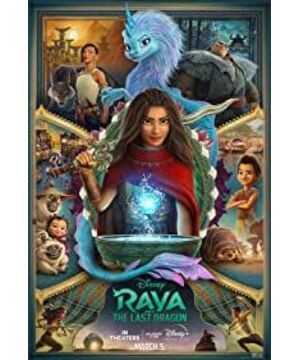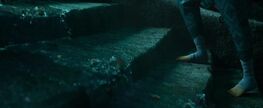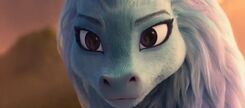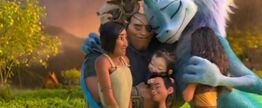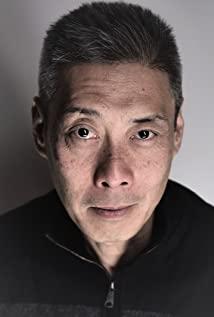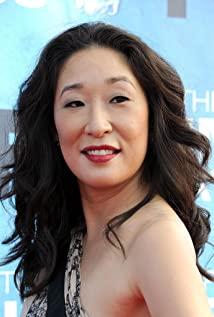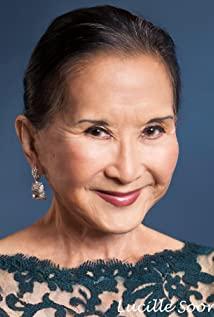"Legend of the Dragon" is not the most creative or deep story in Hollywood or even Disney, and even its play itself has many debatable points, but perhaps because of such a special release time in 2021, let It has a very close metaphorical relationship with the real society invisibly, and perhaps it has become the most worthy of discussion in recent years in Hollywood animation.
From "Dream Travel" to "The Legend of Dragon", not to mention the transformation of the image of dragon from demon to saint, we can see that Hollywood animation represented by Disney is "really" constantly breaking the white center and even the West. The rut of the center, in the attempt to deeply cultivate regional culture, constantly expand the subject matter to Latin America and even East Asia.
However, unlike "Dream Hunting Travel Notes", which is still a place of new bottles and old wines, and recalls the connotation of universal family values with Latin American elements, the original intention of "Legend of the Dragon" may still be to find the universality of unity with East Asian elements. values, but in the moment, it presents some more complex, grander, and more time-sensitive real concerns.
Like conflicts within families, conflicts between nations and even countries are also issues that human beings have never gotten rid of in historical time and space. Therefore, selfishness and suspicion, trust and solidarity in "The Legend of the Dragon" are still universal propositions. But if this proposition is placed in such a special historical period around 2020, its significance may become more focused and far-reaching.
As a "plague" caused by disputes, "Dark Demon" is hard not to think of an unprecedented infectious disease like the new crown that has swept the world. And the siloed governance between countries is precisely in line with the reduction of global mobility, the intensification of localization, the further rise of nationalism, and the shrinking of the legacy of globalization before and after the outbreak of the new crown.
In Legend of the Dragon, a bowl of Tom Yum Kung soup is a clever symbol of the benefits of globalization. When the Patriarch of Ponga tried to use "shrimp slips from Longwei Beach, lemongrass from Longclaw Bay, bamboo shoots from Longji Mountain, chili from Longyagu, and coconut sugar from Longxincheng" to "share the food with people of all ethnic groups" "Food, rather than guns for confrontation, itself represents a utopian miniature scenario in which all human beings "share" the fruits of globalization. In today's society, when David Ricardo's theory that division of labor and exchange can maximize value is widely accepted and utilized, it is not difficult to witness that everyone's life is full of commodities from all over the world, and it is precisely through commodities In exchange, human abundance has undergone an exponential leap in just a century or two.
Here, we may take this "Tom Yum Kung Soup" as a topic of the whole film. If we disassemble it further, we will find that, in addition to the various ingredients mentioned above, which symbolize globalization, the two most important elements in this bowl of soup are also important components that constantly emerge and beckon in the film Parts: One is the "water" as the base of the soup; the other is the "circle" of the soup pot, which is specially presented from a bird's-eye perspective.
The importance of water in the film is self-evident: the black demons are afraid of water alone, the petrified people are set up to pray for rain, and the dragon can only disperse the plague through precipitation... Looking at the fields of folklore and religion, from From the myth of the Great Flood all over the world to the Christian baptism ceremony, the referential relationship between water and divine powers such as "cleansing" and "rebirth" has been deeply rooted in the collective unconscious of mankind. The film uses water as the carrier of salvation, which is naturally a convenient move, but if you consider the further metaphor of water in the film, you have to praise the existence of "water" in the film as a wonderful use. Another metaphor for this is "communication".
The protagonist Raya followed the water to find Xisu, and then searched for the water to retrieve the crystal fragments, and finally "saved the world". The greatest quality of water itself - fluidity - is precisely the bottom plate of the film's story. It can be said that the earliest large-scale communication behavior of human beings was also completed by water transportation. Using water as a metaphor for communication is undoubtedly a very wonderful refinement. It can even be said that from Longwei Beach to Longya Valley, the adventure journey of Laya upstream is not to find crystals, but to meet all kinds of partners through "travel", and return to a kind of communication rationality and dynamic integration. among.
Another interesting element in the film is the "circle". It is not difficult to find that Longxincheng itself is a huge circle, and the "circle" of the crystal goes without saying, and even the prayer gestures handed down from Longyao State are "hands in a ring"... "circle" undoubtedly symbolizes As a perfect figure with an infinite axis of symmetry, it symbolizes connection, unity and the most poetic equality.
In the "Kura circle" discovered by Malinowski, we seem to be able to see how primitive humans created "circles" in real communication. Through exchange, the siloed human beings in a region begin to reunite in the same set of relationships, creating a basis for some kind of communication. Likewise, Moss's "Gift" points us further: There is a delicate relationship of mutual achievement between "exchange" and "social trust." From this, it is not difficult for us to understand why Xisu in the film tried to "exchange" trust with gifts, and why the Patriarch Ponga, who is the comparison entity of Xisu, did not forget to always use "Tom Yum Kung Soup" is used as a medium to practice the ideal of national unity.
Once again, with the connotation of communication and exchange represented by water and circle, we return to the discussion of globalization, a business and political issue. As mentioned in the film, there are long-standing prejudices and misunderstandings among the divided ethnic groups in the kingdom of Longyao, so why is this not the case in the real world we live in? In the imaginary community where the ground is a prison, aren't we all prisoners of some constructed identity labels such as race, ethnicity, and even nationality?
Naturally, we do not want to transcend the country and move towards some kind of false cosmopolitanism. What we need is only the exchange of information brought about by trade globalization and even the exchange of information brought about by trade globalization. Cancel, make "seeing" and "understanding" possible. Because the benefits of globalization are far from commodity trading and common prosperity, but the mutual concealment and ultimate solidarity of human beings.
Just like the dilemma reflected in the film, in the perpetual problem of limited resources and unlimited desires, the contribution of globalization is dwindling day by day - yes, in the face of the boundless selfish desires of human beings, the most explosive wealth growth is nothing but It's a drop in the bucket. In today’s world, globalization has begun to freeze. While the Sino-US trade war is intensifying, Brexit, Middle East conflicts, immigration issues, etc. are further undermining people’s confidence in sharing and acceptance, and the world is gradually turning to nationalism and conservatism. .
Perhaps in the end, the arrow shot at Patriarch Ponga will also be shot at the real Xisu, the most precious magic brought about by globalization-exchange and communication. But sadly, in such a more conservative, more fearful rather than trusting real world revealed by an epidemic, I am afraid that no one wants to take the first step towards the other, "Xunlong "It will eventually degenerate into a "legend" that will only become fading with the growth of the WTO.
View more about Raya and the Last Dragon reviews


